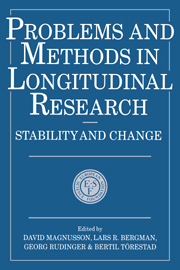Book contents
- Frontmatter
- Contents
- Contributors to this volume
- Foreword
- Preface
- 1 Studying individual development: problems and methods
- 2 Modeling individual and average human growth data from childhood to adulthood
- 3 Intraindividual variability in older adults' depression scores: some implications for developmental theory and longitudinal research
- 4 Now you see it, now you don't – some considerations on multiple regression
- 5 Differential development of health in a life-span perspective
- 6 Assessing change in a cohort-longitudinal study with hierarchical data
- 7 Statistical and conceptual models of ‘turning points’ in developmental processes
- 8 Qualitative analyses of individual differences in intra- individual change: examples from cognitive development
- 9 Application of correspondence analysis to a longitudinal study of cognitive development
- 10 Event-history models in social mobility research
- 11 Behavioral genetic concepts in longitudinal analyses
- 12 Genetic and environmental factors in a developmental perspective
- 13 Structural equation models for studying intellectual development
- 14 Longitudinal studies for discrete data based on latent structure models
- 15 Stability and change in patterns of extrinsic adjustment problems
- Index
14 - Longitudinal studies for discrete data based on latent structure models
Published online by Cambridge University Press: 27 April 2010
- Frontmatter
- Contents
- Contributors to this volume
- Foreword
- Preface
- 1 Studying individual development: problems and methods
- 2 Modeling individual and average human growth data from childhood to adulthood
- 3 Intraindividual variability in older adults' depression scores: some implications for developmental theory and longitudinal research
- 4 Now you see it, now you don't – some considerations on multiple regression
- 5 Differential development of health in a life-span perspective
- 6 Assessing change in a cohort-longitudinal study with hierarchical data
- 7 Statistical and conceptual models of ‘turning points’ in developmental processes
- 8 Qualitative analyses of individual differences in intra- individual change: examples from cognitive development
- 9 Application of correspondence analysis to a longitudinal study of cognitive development
- 10 Event-history models in social mobility research
- 11 Behavioral genetic concepts in longitudinal analyses
- 12 Genetic and environmental factors in a developmental perspective
- 13 Structural equation models for studying intellectual development
- 14 Longitudinal studies for discrete data based on latent structure models
- 15 Stability and change in patterns of extrinsic adjustment problems
- Index
Summary
INTRODUCTION
This chapter is intended to be partly an exposition of some selected discrete data models for longitudinal data, and partly an illustration of their applicability. It is not the intention to give a complete survey of existing models, and the list of references is not complete in any sense. The interested reader will, however, by consulting one or more of the listed references, quickly be guided into the literature on the subject.
Firstly, two data examples are presented. Secondly, a number of latent structure models are presented with emphasis on model structures and very little on the more technical aspects such as estimation methods, test statistics and numerical procedures. Thirdly, the given models are applied to the two examples.
TWO DATA SETS
Longitudinal data are data where individual characteristics or individual responses are observed for the same individuals at various points in time. In this chapter, we shall, for ease of presentation, limit ourselves to two and three time points.
Data set 1 is presented in Table 14.1. The table shows the observed score on a psychiatric questionnaire with 12 items. The score was observed for 1460 individuals in 1974 and again in 1978. The table shows the observed frequencies of the joint observed score (i, j) where i is the score in 1974 and j the score in 1978.
- Type
- Chapter
- Information
- Problems and Methods in Longitudinal ResearchStability and Change, pp. 308 - 322Publisher: Cambridge University PressPrint publication year: 1991
- 3
- Cited by



